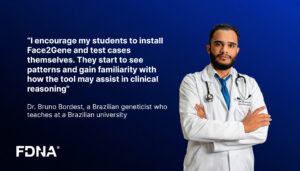posted on 29 March 2018
INFORMA CONNECT
“Face2Gene algorithms are using facial analysis and HPO terms to help doctors and pharma recognizes patients with phenotypes related to diseases, such as Sanfilippo Syndrome (MPSIII). These technologies are improving the identification of biomarkers and phenotypes and accelerating the discovery of correlations between disease and the plethora of patient data available.”
The article examines the transformative impact of neural networks and AI on the drug industry, highlighting the Face2Gene platform by FDNA. Face2Gene utilizes advanced neural networks to analyze facial phenotypes, aiding in the diagnosis of rare genetic conditions. This technology improves the accuracy and speed of identifying genetic disorders, showcasing how neural networks are revolutionizing medical diagnostics and drug discovery. By integrating AI and deep learning, Face2Gene exemplifies the future potential of personalized medicine and innovative healthcare solutions in the pharmaceutical industry.


